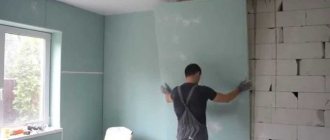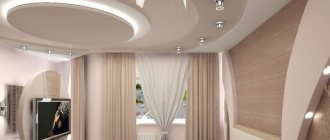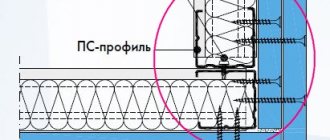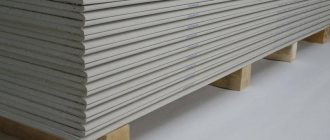A dressing room is a specially designated space in a room where items of clothing will be stored. Typically, dressing rooms are made in the bedroom, where people most often change clothes, but it can be built in another convenient place. A dressing room made of plasterboard saves not only space, but also money.
When there are too many clothes and they are scattered literally everywhere, then even a small dressing room of 3-4 square meters saves the situation. Using drywall to create it, you can significantly save on building materials.
Requirements for a dressing room
It’s easier to make a plasterboard dressing room without an open top.
Before you dive into work, you need to understand what a dressing room should be like. Everything is thought out in order to organize the storage of clothes and shoes, as well as to have quick access to them. It’s clear that you need to save space as much as possible. Let us immediately note that a dressing room is made with your own hands from plasterboard in large rooms. There is no point in creating it in a 2 by 3 meter room.
You may not need to do anything at all, because often closets are converted to store clothes. But if there is no pantry, then you will have to create everything yourself.
There is no point in making a dressing room less than 1x1.5 meters. If it is even smaller, then no layout will help to properly store things in it. The more things, the larger the area. If you need to store a lot of dresses, then the space for the dressing room should correspond to this volume. The fact is that long clothes take up height, which means there will be fewer shelves and, accordingly, less space for other clothes or shoes.
Design options
Creating a dressing room from plasterboard will take you no more than 2-3 days, but before installing the structure, you should carefully consider all the important aspects: convenient location, dimensions of the structure and its functional content. All these factors must be taken into account at the design stage in order to avoid mistakes.
Selecting a location
Many apartments have ready-made “cubbies” and storage rooms that can be used as a dressing room. In this case, you only need to worry about constructing shelves and installing the necessary fittings. If your apartment or house does not have suitable premises, you can allocate space for a dressing room in one of the rooms or in a wide corridor.
Most often, such storage rooms are installed in spacious bedrooms. For the construction of the structure, so-called “dead” corners are allocated - areas that are either not used at all or are occupied by cabinets and chests of drawers.
When choosing a location, keep in mind that the optimal size of the structure should be at least 1 * 1.5 meters; in a smaller area you simply will not be able to conveniently place all the things that need to be removed.
Configurations
There are several configuration options for storage space:
- "Corridor". With this option, the new room is stretched along one of the free walls. Racks with shelves and rods are built in a fenced-off area. Although such a design allows you to remove all things from the bedroom, it is considered not very convenient - in a cramped passage you will most likely feel uncomfortable sorting out your wardrobe.
Square. In this case, a square or rectangular area is allocated in the room. The spacious design will allow you to conveniently place shelves with shelves, shoe racks, and even - if the bedroom area allows it - an ironing board or dressing table.
Corner. Another option for creating a spacious room for storing things, which does not stand out so clearly in the interior and does not take away useful space from the bedroom.
Polygon. The free configuration of the contours of the new room will optimize the consumption of usable space in the bedroom and dressing room. “Growing” out of the corner, the structure with its walls will create a comfortable room geometry.
The choice of configuration should be based on the availability of free space in the bedroom
It's important to strike a balance here so that new additions to the room don't make it even cramped than the cabinets you're trying to get rid of.
Doors
Since the very concept of a dressing room includes a certain isolation, you should think about the design of the entrance to it. The door should be comfortable and not take up useful space both in the new room and in the bedroom.
It is clear that using swing doors is not the best choice. The optimal option would be retractable canvases or lightweight folding structures. A specialist store will help you choose the perfect door.
But you don’t have to use the doors at all, leaving the passage to the room open. In this case, the opening can be designed in the form of an arch - the rounded shape will give the structure intimacy and airiness.
Space planning
So, you have decided on the configuration and area of the future plasterboard dressing room. After this comes the most critical design stage: planning its internal space.
First, the depth of all shelves is included in the drawings: as a rule, 55 cm is enough. This size is enough to optimally place things, seasonal blankets on horizontal surfaces, and also conveniently place longitudinal rods for hangers.
After this, the space is distributed into several functional areas, usually divided into three levels:
- upper, for storing bulky and rarely used items (tourist equipment, tools, hat boxes, etc.);
- medium, for storing clothing itself;
- bottom, for storing unused shoes.
The last two levels are predetermining when planning. The height of shoe racks or shelves for storing shoes should be set aside from the floor, and then distribute the remaining space for shelves and areas with rods:
- the optimal height of shelves for things is 40 cm;
- height of the area for shirts, jackets and blouses - 100 cm;
- the height of the area for storing dresses, suits and outerwear is 150 cm.
In addition, when planning the space, it is necessary to select one of the walls for a large mirror and organize optimal lighting in the created room, since there will be no natural light in it.
Choosing a place in the apartment
Since there is no convenient storage room, you need to find another suitable place. A plasterboard wardrobe in the bedroom is an obvious option. Let's look at all the possible places.
If properly decorated, the dressing room in the bedroom will be invisible
- Bedroom. Usually has a large area and is an ideal option. Things are always at hand and in quick access.
- Pantry. A very economical option if available. Problems arise only with dimensions (they are predetermined) and ventilation.
- Dead end of the corridor. If there is a long corridor that ends in a dead end, then this is an ideal place for a plasterboard dressing room. But such situations are extremely rare.
- Hall. If the apartment has a hall, then it always has the largest area. You can also make a dressing room in it, but not everyone has such a room.
- A balcony or loggia can be a good place for a plasterboard dressing room. However, for this they must be insulated. It is also necessary that there is heating there, otherwise in winter things will simply deteriorate. You will have to use moisture-resistant drywall and insulation between the sheets.
Location rules
You should think about the design of a bedroom with a dressing room in advance, for which a competent project is drawn up. It is permissible to do it yourself, for which a lot of photos are posted. A specific project is selected, to which the apartment owner makes additional changes. It is often impossible to carry out all the steps on your own, and photo design does not help either, and at the same time it is advisable that a dressing room in a small bedroom be created by professionals.
The first stage of the project is choosing a location for the dressing room in the bedroom. To do this, select one of the options:
along the wall with a window - dividing the space next to the window is considered a good solution. It is optimal to build a small niche structure. A dressing table is installed next to the window, making it possible not only to try on clothes, but also to comb your hair, paint, or perform other actions that require a mirror and high-quality lighting. corner option - the structure occupies a free corner of the room. Most often it is closed with swing or sliding doors. This design looks great in any room and works well in the corner at the head of the bed. A suitable option for a square or non-standard room; along a long empty wall - this option is suitable for a large room
The partition will be created from plasterboard or plywood, after which it will be covered with any pre-selected finishing material. It is important to pay attention to proper lighting, since there will be no natural light in a separate space;
Along the wall with a window
Along the wall
Corner
Most often the rooms are quite large, so the bedroom is 18 sq. Bedrooms of 18 square meters are considered easy to renovate, since you can allocate a lot of space for a compartment with things. If this space is organized correctly, it can be effectively used not only for storing clothes and shoes, but it will also be possible to place various suitcases and bags, a sewing machine and other household items that are used quite rarely.
Layout features
Before starting work, you need to find out how much material is needed for the job. To do this, you need to understand the layout. Only by solving this issue will it be clear how many sheets of drywall, screws, profiles and other things are needed.
If nothing limits you in the layout, then it might make sense to order a huge wardrobe or hire workers to do everything. If the financial issue is acute, then every detail should be thought through. A DIY dressing room made of plasterboard will help you save money if you think economically.
Corner dressing room is an economical option
The first step is to understand how much free space there is. If it is possible to allocate 6-8 square meters, then this is ideal. If not, then you will have to get out. After determining the footage, you need to decide how many compartments will be allocated for shelves, and how many for clothes hangers. Usually they make 1-2 shelves at the bottom, then on top there is space for hangers with clothes, and above that there are 1-2 more shelves for other things. And this is done in several sections.
A characteristic feature of the dressing room is the presence of doors. They need to be designed so that it is convenient to enter. Poorly designed doors reduce the usable area of the room.
To summarize, we can say that it is necessary to know in advance the area of the dressing room, as well as its layout. Ideally, draw a sketch where everything will be provided. This sketch will be needed in the work to create a frame from metal profiles and cover it with sheets of plasterboard. Therefore, you need to know where the opening for the door will be created, where the fastenings for the bar will be, and where the shelves will be attached.
Where to do
Even in small apartments there are “appendicitis” that cannot be used normally. This is where you can make a dressing room.
Another popular option is a pantry. In this case, everything is generally simple. You remove everything unnecessary, change the doors and install the appropriate content: racks, racks, baskets, shelves.
Dressing room from the pantry
If there is nothing like this in the apartment, they fence off part of the room - the end or the corner - you need to look at the layout. The good thing about a corner dressing room is that it allows you to use the most difficult areas to arrange, namely the corners. Especially if there are closely spaced doors in two adjacent walls. This zone is considered “dead”: you can’t put anything there except a small corner shelf: everything will get in the way. About the same option - two windows or a window and doors.
Corner dressing room
If the area turns out to be too small, it is possible to increase it a little, making the wall not flat, but with the middle extended slightly. This will not reduce the area of the room much, but much more things can fit.
A way to increase the area a little
They are also made on the loggia - by making part of the glazing opaque or by building a wall. Only here you can’t do without insulation - it’s unpleasant to wear cold clothes in winter.
Dressing room at the end of the balcony or loggia
The second option is suitable for wide loggias. In them, shelving can be placed along a long wall.
Option for using a balcony
In the corridor or hallway, a corner or “appendix” is also fenced off, if the layout allows. Here everyone can decide only by location: there is a place for this or not.
A dressing room is most appropriate in the bedroom. This is simply the best place to store things: in the sense that it’s more convenient to dress here. Therefore, for these purposes, part of the room is fenced off. In this case, a partition is needed and most often it is made of plasterboard. This technology has long been known and worked out to the smallest detail. It won’t take much time even if you have no experience: a maximum of two to three days for assembly and finishing.
If you make a partition from gypsum board or gypsum board according to all the rules, you will need double cladding, and this will “eat up” centimeters, or even meters, of area. Therefore, most often they are sheathed only on the outside, but in two sheets with overlapping seams. When assembling the frame, do not forget to make reinforced racks for fastening the door. With single cladding, exposed profiles remain inside, but it is convenient to hang shelves-baskets for things on them. If you plan to do this, then take them with a thick wall so that they can hold the weight properly.
Plasterboard partition for dressing room
The partition can also be made from laminated chipboard or OSB, or MDF board. This is an option for those who do not like to bother with putty. But you need to choose a lamination that will fit into the interior without any problems.
The interior design of a one-room apartment is described here.
What to consider in the project
Constructing a dressing room from plasterboard is much faster if you have a project or sketch. In the project, you need to designate in as much detail as possible both the entire dressing room and each section separately. You need to be especially careful when drawing designs with a beveled corner. What a dressing room layout might look like:
The standard depth of the shelves is 50 cm (no longer required), and the distance between them does not exceed 40 cm. The space parameters for the clothes rail depend on the type of clothing. Perhaps you will only have shirts and jackets there, or perhaps you need to provide space for evening dresses.
In the project, we do not forget about the thickness of the walls, otherwise it often turns out that the dimensions turn out to be smaller than planned. The thickness of the walls consists of the width of the profile used and the thickness of the plasterboard with which it is sheathed.
Often a dressing room made of plasterboard is left without doors. At least they are not taken into account in the project. The door width should be 80 cm (in extreme cases - 60 cm). Many people get into real trouble with them. Doors made of plasterboard or other material are always a problem area in the dressing room due to the complexity of their installation. Some people use a sliding door system, others choose a swing design. Some people refuse doors altogether to avoid fooling around. Everyone makes this choice independently.
Conclusion
A dressing room is not a luxury, but a very rational design for storing all your things; you can do without closets, which will make your rooms more stylish and modern. The video in this article will help you understand some of the nuances in more detail, and if you have questions on the topic, write them in the comments under this review.
Did you like the article? Subscribe to our Yandex.Zen channel
September 28, 2016
Plasterboard systems, Design, Design of other rooms
If you want to express gratitude, add a clarification or objection, or ask the author something, add a comment or say thank you!
Preparation of materials, tools and other devices
When all the preliminary work has been completed and there is an understanding of how much of what is needed, then it’s time to move on to purchasing. For work you will need the following consumables:
- ordinary drywall 12.5 mm thick. It is necessary to calculate the required area in advance and convert it into the number of sheets, taking into account cutting;
- metal profile 50x50 mm. The design is quite simple and without additional burdens, so you can get by with one type of standard profile;
- metal screws 25 mm or 35 mm for fastening drywall;
- dowels for attaching profiles to the floor and ceiling.
Since the plasterboard wardrobe will need finishing, primer and putty will also be required. In addition, you will need the following working tools:
- knife for cutting drywall sheets;
- metal scissors for cutting profiles;
- cutter for fastening profiles together (you can use small metal screws);
- screwdriver and drill for screwing in screws and creating holes for dowels;
- roller with spatula for primer and putty;
- level.
Some advise for some reason to insulate the dressing room, but if it is in the bedroom, then there is no point in this. Even in other heated rooms, insulation will only be an additional expense that will not bring any benefit. An important point is lighting. It is not necessary for small areas, but for a large dressing room light is necessary. Therefore, you should purchase the necessary wires and lighting fixtures.
This is a more or less standard list of what is needed, but it can be expanded. For example, hinges, door handles, sliding door systems, etc. may be required.
Assembling a frame from a metal profile
This is what a simple frame for a dressing room looks like.
Now it’s time to talk about how to make a dressing room from plasterboard with your own hands. You need to transfer the drawing to the wall, floor and ceiling so that you can see where to attach the profiles. The frame will be assembled from a metal profile, so you need to mark everything correctly. Since the dimensions of the structure are small, you can manage it using a level, tape measure and pencil. The profile is used instead of a ruler.
The places where the profile will be attached to the wall are marked on the floor, wall and ceiling. A step of 40-60 cm is quite enough. In these places, the surface is drilled for dowels (dowels themselves measuring 6x40 mm are quite suitable). The profile is applied to the surface and holes are also drilled in it, and then it is secured with driving screws. This is how the profile is attached in all places where it touches the wall, ceiling or floor. Some people use a rack profile for these purposes, and the rest is assembled into a structure from guides. Others prefer to carry out all work with a guide profile. Neither option is wrong.
Before installing profiles to the wall, ceiling and floor, it is advisable to lay sealing tape at the fastening points. It is used for additional sound insulation and reduces the level of vibrations of the entire structure. When things are put on a shelf, doors are closed or coats are hung up, there will be much less noise.
When assembling the box, it is important to take into account the space under the door so that the profile does not run along the floor. Since the dressing room is made of plasterboard, additional reinforcement of the frame in the doorway may be required. Also, the entire frame is reinforced around the perimeter with the help of jumpers, which are inserted into the assembled box in increments of 60 cm. The racks are attached to the frame with metal screws 25 mm long. You need to make sure that one of the posts goes through the place where the tramp rod is attached.
If the dressing room already has an outlet, then great. If not, then you need to think about how to bring it through profiles. You should also do the wiring at this stage if there are several light sources in the dressing room. If you also make shelves from plasterboard, then it will be a very labor-intensive dressing room. And such shelves take up a lot of space. But built-in partitions for dividing the dressing room into sections can come in handy. They are made in the same way as the base frame.
Useful tips for arrangement
Not everyone has the opportunity to install huge storage facilities for things. Often you have to be content with more modest premises. But even in the smallest dressing room (1 x 1 m) you can create all the conditions so that every item has its place.
Some tips:
- the space of the room will look visually larger if you use glass or glossy doors and lighting built into the shelves;
- drawer dividers will allow you to store belts, ties, and jewelry in a systematic way;
- inscriptions on drawers and boxes with lids will help you find the necessary items faster;
- to avoid the appearance of musty odors and dampness, good ventilation must be provided;
- It is necessary to promptly get rid of things that have not been used for a long time, which will allow you not to create a mess in the room and free up space on the shelves.
It is recommended to design the optimal arrangement of boxes, containers and organizers made of plastic, fabric, straw or wood. They are ideal for storing belts, ties, scarves, gloves, and clothes that do not require ironing. In addition, such storage systems help save space on shelves and quickly find the things you need.
Plasterboard covering and finishing
The plasterboard is fastened with self-tapping screws in increments of 15-20 cm.
Sheathing the entire structure with plasterboard begins from the inside. Where possible, whole sheets are used, and in other places they are trimmed. It is important that the edges of the sheets fall on the profile, otherwise their fixation will be problematic. Self-tapping screws 25 mm long (maximum 35 mm) are used for fastening.
Drywall must be screwed in all places where it comes into contact with the profile. The screw heads should not stick out; they should be slightly deepened so that the surface remains smooth.
When a plasterboard dressing room is lined from the inside, you need to provide space for sockets, lamps or wire outlets. Depends on the project. A cavity is formed between the sheets of drywall (inside and outside the dressing room), in which it is convenient to route wires for future lighting. Some people carry out additional insulation and sound insulation, but for a dressing room in the bedroom this is clearly a waste of time and money.
When all the sheets of drywall are secured, you need to putty all the joints and screw heads. The joints are additionally strengthened with reinforcing tape so that they do not cause cracks in the future. It is also necessary to putty all corners. Trimmed seams must be primed before puttying to prevent the mortar from falling off. After puttying, the surface of the dressing room will become uniform and ready for finishing.
Dressing room before and after finishing
Further work depends on the type of finishing coating chosen for the dressing room. Its walls can be simply painted or covered with wallpaper. Some people add additional decorative panels or plywood. Some people like covering walls with mirrors.
Finishing touches
In essence, the creation of a plasterboard dressing room is complete. However, there are a few more points worth paying attention to.
In particular, we are talking about the trampoline rod. It will bear the maximum load in the dressing room, so high-quality fastening should be carried out. It is best when the rod is attached not only to the drywall, but also to the profile, which is part of the frame. Then the entire load will go not to the gypsum board, but to the profile, which is much more reliable.
The question of doors also remains open. The easiest way is to purchase sliding doors with a special system so as not to do everything yourself. This option will be optimal in terms of saving space. It is worth thinking about ventilation. It's not very good when everything is clogged.
As a finishing coating, it is recommended to use wallpaper that matches the room. Gluing them requires minimal preparation of the drywall. And in this case, the dressing room made of plasterboard will merge with the room.
As for the different shelves, they can be made from different materials. These can be plasterboard shelves, but you need to know how to make them. If there are too many shelves, the work will be protracted. You can learn how to make shelves in a dressing room from the video.
What needs to be calculated before starting work on organizing a dressing room?
There are several things that need to be considered before you begin organizing your closet. These include:
- Location. This has already been addressed.
- Square. It’s good if you can allocate 6 square meters. Minimum – 2 square meters. When deciding on the area, think about what you will put in the dressing room. For example, if only casual clothes and shoes, then a minimum of 2 square meters will be more than enough.
- Door. It should not create obstacles. Choose a coupe type door (sliding in different directions).
- Designs for storing clothes and shoes. They should be attached wisely and not in a chaotic manner.











